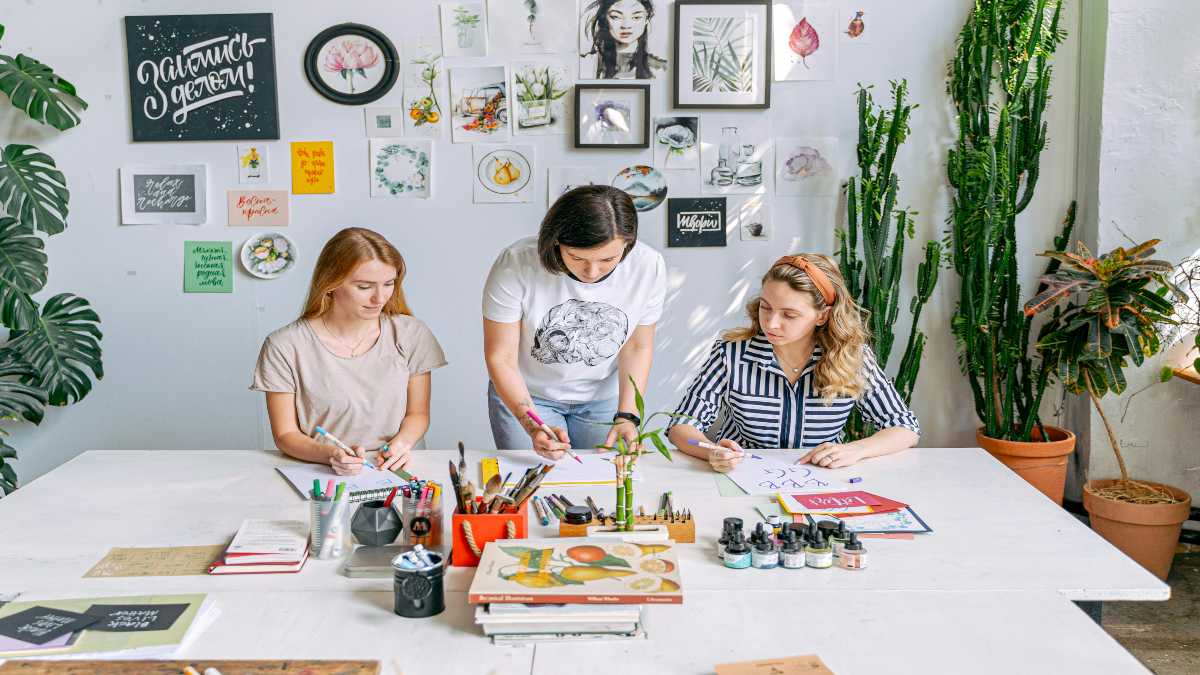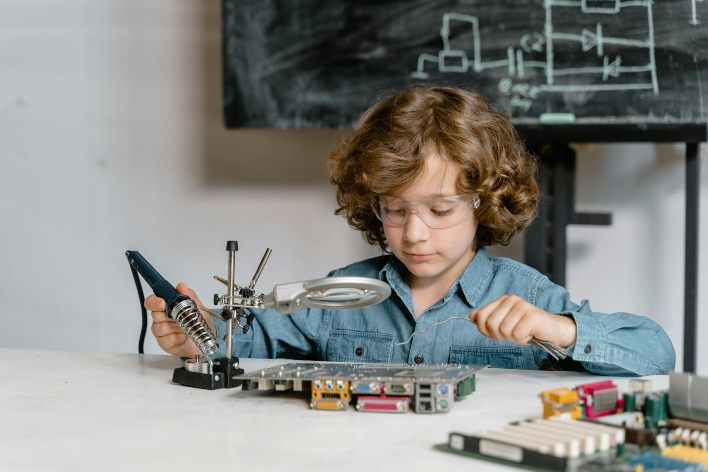How to Foster Innovation Through Hands-On Learning Experiences

In the fast-moving world, innovation is the key to survival. Innovation and fresh ideas set numerous things moving in many fields, from technology to science. One of the best ways to encourage innovation in a person's mind is through Hands-On Learning for Teens. This method engages students actively and encourages them to think creatively, to solve problems, and to explore new ideas.
Experiential learning, otherwise known as hands-on learning, advances far beyond lectures and textbooks because it enlists learners directly in the learning process. This method is very effective among teens since it allows them to take control of their education, stretch the knowledge acquired into practical life, and witness up, close how ideas may spur innovations.
The Importance of Hands-On Learning for Teenagers
Hands-on learning for Teens is important because it enables pupils to engage in the learning process completely. They will not merely absorb information but start to become an active learner. They can test their ideas, possibly fail, and learn from failure, a process that should occur when innovation occurs.
Hands-on learning also appeals to teens because it makes education relate more closely. For example, students can view how they might apply what they learn in a classroom through Creative Learning Projects or through activities whereby learners could apply classroom lessons in practical ways to everyday life. In such ways, it helps foster their deeper understanding and interest and motivates them toward further exploration and innovation.
How Hands-On Learning Can Foster Creativity
Innovation thrives when creativity is fostered. It brings about the manifestation of creativity in students through outside-the-box thinking as well as finding a multitude of solutions for one problem. In contrast, most conventional methods of education would seek out that one answer that was deemed "right, while hands-on learning provided a field for experimentation so that students could find their own means of success.
Innovative education strategies, like project-based learning or STEM activities, provide teens with the ability to explore and think critically while learning that failure is not the end but an opportunity to try again, make adjustments, and improve designs or solutions.
For example, in a model bridge-building project, a student may begin with a structure that collapses at the minimum amount of weight. Hands-On Learning for Teens does not see this as a failure but as a chance to analyze what has gone wrong, think again about the design, and build an even better bridge in an altogether different approach using more productive material. This sort of iteration forms the backbone of creativity and innovation.
Innovative Education Strategies and Their Contribution to Innovation
Educators foster innovation through experience-based learning through Innovative Education Strategies that enable adolescents to take calculated risks when exploring new ideas and experiencing learning, some such strategies are open-ended projects, cross-disciplinary learning, and activities that encourage collaborative activities, during which the students are challenged to think critically and creatively.
In the hands-on learning setup, educators are playing more of the role of guides as opposed to lecturers. They will provide necessary tools, resources, and support to enable students' curiosity in problems to propel exploration, yet step back and allow students to become a little more in charge of their learning. Ownership is important in the process of building an innovation culture.
The teacher then leads students to a Creative Learning Project through which they create a product that can help solve real problems, such as plastic waste or mobility for people with disabilities. Students brainstorm, research, prototype, and present their solutions, all this in conjugation with their peers. It's an innovative way of learning while building essential life skills like teamwork, communication, and problem-solving.
Hands-On Learning for Teens: Such a domain of exploration embodies the very heart of innovation while building problem-solving skills in teenagers. In traditional classroom settings, students are more likely to memorize and regurgitate facts rather than think about and apply this knowledge in new ways.
One of the advantages of hands-on learning is that it closely mimics real-world problem-solving. Professionals do not, after all, come prepared with many answers to any given problem; instead, they dig test, and refine their ideas to settle on a resolution. Hands-On Learning for Teens simulates this process because of the freedom students are given to try things out, make mistakes, and refine their solutions over time.
For instance, in a practical science classroom, the water filtration system would be an experiment to be assigned to the students. They have to work on material usage as well as material cost, and how easy it would be in operation while keeping environmental impact in mind. Again, if they test these filtration methods, they come to understand which of them works the best. Through this entire process, they learn to analyze the problems, test hypotheses, and critically think about how to improve the design with them as an innovation requirement.
Hands-on learning would, of course, encourage individual creativity and problem-solving but, above all, proposes the element of collaboration. Innovation is apt to occur when various minds are talking, sharing ideas, and working toward a common goal. Hands-On Learning for Teens offers ample opportunities for students to make projects collaboratively and build from other classmates' perspectives to enhance other's strengths.
Cooperative work can foster creative thinking, social learning, and communication skills while learning how to listen to many other points of view, negotiate one's ideas, and, especially important in today's workplace, work together toward a common outcome.
For instance, in a classroom dedicated to Creative Learning Projects Students could work together on designing a solar-powered car. Each student in that team might come in with his or her strength, in design, engineering, or problem-solving. By working together, students learn each other's values of diversity in ideas and experiences: an important component for encouraging creativity.
Using Technology with Hands-On Learning

Technology plays an important role in how Hands-On Learning for Teens is made real: technology opens doors for students to have high-tech equipment and resources encouraging innovation and creativity. Whether it's 3D printing or coding software, technology has enabled teens to do things they could only have imagined before testing, designing, and creating.
For example, students can utilize 3D printing technology to prototype an idea for a product development assignment. This would allow them to bring concepts to life as products and test designs rapidly and efficiently. Other uses of the technology are virtual collaboration in that the student can work on a project even though he or she might not be in the same physical location as his or her colleagues.
The use of technology in hands-on learning not only makes the whole process interesting for students, but it is also a valuable asset that helps them build good digital literacy and, hence, stay on track with what is required to be successful in this world.
Examples of Hands-On Learning for Teens
There are a multitude of ways in which Hands-On Learning for Teens can inspire innovation across curriculum areas: an interactive museum exhibit in a history class or understanding the material through a reenactment of historical events. In an art class, perhaps, students are experimenting with myriad mediums and techniques to produce original pieces of work.
One of the most prominent examples of hands-on learning is project-based learning. In this, the students are undertaking a long-term project that requires research, creativity, and collaboration for its completion. PBL, most of the time, takes a real-world problem to encourage students to think creatively about how to solve the problems identified. This method of teaching is an excellent means of encouraging innovation because it places knowledge application in practical and creative ways.
Conclusion
Hands-On Learning for Teens is an incredibly powerful platform through which innovation and creativity can find full expression in young minds. Overall, hands-on learning engages students in real-world projects, encourages teamwork, and fosters a growth mindset, teaching teens the skills they need to become innovative. When considering future changes in education, hands-on learning will surely take on a very important role in preparing them for challenges and opportunities. Teens would learn to be adept, assuming hands-on learning, not only improving their academic understanding but also picking up the thinking, creativity, and problem-solving skills that determine success in the world.
FAQs
1. What is Hands-on Learning for Teens?
Hands-On Learning for Teens is a learning process that is formally known as student-investigatory-activity-led education. For instance, this learning becomes more enhanced in the real world since creativity and problem-solving abilities are boosted.
2. How does Hands-On Learning for Teens foster innovation?
Involving hands-on projects in learning allows for the development of a more critical thinking and creative solution environment. In this process, innovation comes in as well because students can conduct experiments, make mistakes, and improve ideas.
3. Why Hands-On Learning for Teens is important in learning?
Hands-on learning for Teens creates a more enjoyable and interactive learning experience because it involves ownership of students in the teaching and learning process. The experience also helps to imbibe core skills such as critical thinking, creativity, and collaboration, all necessities in today's career.
Hope you liked what you read? Feel free to share this article with your friends and spread the knowledge!
Related blogs
How to Incorporate Environmental Education into Middle School Curriculum
Other Related Section
NCERT Solutions | Sample Papers | CBSE SYLLABUS| Calculators | Converters | Stories For Kids | Poems for kids| Learning Concepts I Practice Worksheets I Formulas | Blogs
Admissions Open for
CBSE Schools In Popular Cities
- CBSE Schools in Bangalore
- CBSE Schools in Mumbai
- CBSE Schools in Pune
- CBSE Schools in Hyderabad
- CBSE Schools in Chennai
- CBSE Schools in Gurgaon
- CBSE Schools in Kolkata
- CBSE Schools in Indore
- CBSE Schools in Sonipat
- CBSE Schools in Delhi
- CBSE Schools in Rohtak
- CBSE Schools in Bhopal
- CBSE Schools in Aurangabad
- CBSE Schools in Jabalpur
- CBSE Schools in Jaipur
- CBSE Schools in Jodhpur
- CBSE Schools in Nagpur
- CBSE Schools in Ahmednagar
- CBSE School In Tumkur











